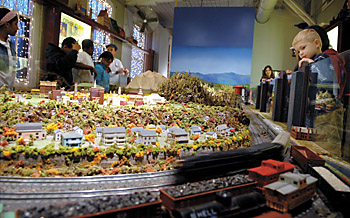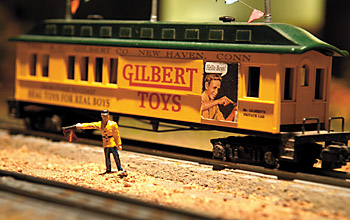 | Children can operate the trains themselves using levers. |
University staff member Walter Zawalich may not be called "The Man Who Saved Christmas" -- a nickname given to the famous New Haven-based toy inventor and Yale alumnus A.C. Gilbert in 1918 -- but there are some who think of him as a holiday-season hero of sorts.
Gilbert, a 1909 graduate of the School of Medicine, earned his epithet for successfully lobbying the U.S. government not to halt the production of toys in American factories during World War I. Zawalich, a senior research scientist and a lecturer at the School of Nursing, is known at the Eli Whitney Museum in Hamden as the person who makes the former A.C. Gilbert Company's American Flyer line of electric toy trains run smoothly each year.
The vintage toy trains are the focus of an annual holiday exhibit that attracts thousands of children and adults, some of whom return to the Eli Whitney Museum again and again to see the miniature locomotives running along their tracks.
The Yale researcher volunteered his expertise to the museum after he restored the motors of some American Flyer trains he got for Christmas as a child. Zawalich was fascinated with the trains while growing up in Worcester, Massachusetts, but had packed them away when he was in high school. Some 30 years later, his sister, Ellen, asked him if he wanted them back. The trains are now collectibles.
"By then, I had kids and grandkids, so I learned how to fix them," says Zawalich. "After that, I approached [Eli Whitney Museum director] Bill Brown and mentioned that I could fix some of the broken trains in the museum's collection."
The A.C. Gilbert factory, which was located in the city's Fair Haven neighborhood, closed in 1966, so Zawalich has to be resourceful in his quest to obtain motor parts. He has scavenged some parts from other broken American Flyer trains and bought others on eBay. He also located a company in Utah that makes motors that fit the American Flyer trains.
"There are many local people still around who worked at the Gilbert toy factory, and sometimes they offer the museum trains that they had gotten while they worked there," says Zawalich. "There are a number of people who have been very generous in donating trains to the museum. I'm always grateful for that."
While the tin-plated American Flyer trains are considered very durable, the old motors do break down often, and in the past the trains sometimes malfunctioned shortly after the exhibit opened, says Zawalich.
"When Gilbert built the trains, they were intended to run for 15 to 20 hours a year, but at the museum we're running them up to 8 hours every day," the Yale researcher explains.
Since Zawalich has been restoring the trains, malfunctions are more rare, according to Brown.
"There's nothing more discouraging than coming here and seeing trains that don't work," says Zawalich. "I'm here still testing them on the morning of the day the exhibit opens."
The Eli Whitney exhibit, which opened the day after Thanksgiving and runs through Jan. 7, features passenger cars, coal cars, box cars and other train cars. Some run along tracks built into a realistic, historic New Haven landscape designed by Hunter Nesbitt Spence. Scenic artists and a model maker also contributed to the exhibit, which includes a city scene, a circus and farmland.
Just one week after the exhibit opened, Zawalich is thrilled to see the trains running flawlessly when he visits the museum with his five-year-old grandson Owen Donegan. Zawalich is as enthralled with the exhibit as his grandson, who is also a lover of trains.
"See, see, you're moving that train," Zawalich calls out with enthusiasm to a student from New Haven's Wexler/Grant Community School in New Haven, pointing to a locomotive that has just traveled under a tunnel. The teenager is visiting the museum as part of the Dwight Hall Academic Mentoring Program at Yale, which pairs Yale students with youngsters at the elementary/middle school for a long-term mentoring experience.
Zawalich circles the platform on which the trains run, talking excitedly about the trains to his grandson and other museum visitors. He points out a train in a display case -- the same model he received as a gift during childhood -- called The Royal Blue, which was built in 1950.
"We often use this non-toxic, cedar-scented fluid and the aroma is unbelievable," comments Zawalich. "For me, it's the smell of Christmas. It conjures up a lot of memories."
Asked what makes toy trains such a part of the holiday season for many families, Zawalich replies, "I think it's nostalgia," noting that the trains remind people of a simpler, more old-fashioned time, albeit one that is somewhat romanticized.
Zawalich's passion for trains has prompted one of his grandchildren, three-year-old Danny Zawalich, to call his grandfather "Grandpa Choo-Choo."
At the School of Nursing, Zawalich is better known for his work as part of a team that includes his wife, Kathy Zawalich, a research associate, and lab assistant Greg Tesz. The scientists are engaged in research on beta cells, which make and release insulin. The destruction or dysfunction of these cells causes diabetes. The Zawalichs' research, supported in part by the National Institutes of Health, focuses on how beta cells function and on understanding what happens when the cells do not work properly. Their ultimate goal is to create cells that better secrete insulin.
Zawalich says his wife, who was his "high school sweetheart," is very supportive of his train restoration work.
"She puts up with our having train pieces all over the house," comments Zawalich. "She'll come to the museum and see the same thing we see with our grandkids: All the kids who visit the exhibit enjoy the trains just as much. Seeing that excitement, they all become your 'grandkids.'"
At the Eli Whitney Museum, one preschool-aged boy begins to cry as he leaves with an adult visitor. "He wasn't ready to part from trains," Zawalich comments in a sympathetic voice. His own grandson, Owen, is more cheerful about leaving. "I'm sleeping over Grandpa's house tonight," he proudly announces. "He has trains there."
Someday, Zawalich hopes, Owen will be able to carry on his grandfather's work fixing toy trains. "It's a labor of love," says the Yale researcher.
-- By Susan Gonzalez
T H I S
Yale scientist helps keep museum's
trains chugging along

One of the vintage train cars designed by the A.C. Gilbert Company, which was located in the Fair Haven section of New Haven.
"It was like an angel visiting us," recalls Brown of Zawalich's offer several years ago to help restore the trains, which range from 40 to 60 years old. "He's given life to the trains by putting in new motors, making them run like new."

Yale's Old Campus and the New Haven Green are featured in the realistic landscape through which the trains travel.
"Look how pretty it is," the Yale researcher coos. Then, he fetches fluid from a museum office, carefully pours some into a small vessel in the engine, and shows children how the miniature trains can smoke the same way real ones do.
The Eli Whitney Museum is located at 915 Whitney Avenue, on the Hamden-New Haven border. The trains run noon-5 p.m. Wednesday-Friday; 10 a.m.-3 p.m. on Saturdays;
and noon-5 p.m. on Sundays and on Tuesday, Dec. 26. The museum is closed on Christmas and New Year's Day. Visitors to the exhibit can also craft trains of their own with interchangeable wooden parts and tools. The trains link with magnetic couplers. Project kits are $8.
 W E E K ' S
W E E K ' S S T O R I E S
S T O R I E S![]()
 Gift from alumni to expand Grand Strategy Program
Gift from alumni to expand Grand Strategy Program![]()
![]()
 State gives Yale $7.8 million for stem cell research
State gives Yale $7.8 million for stem cell research![]()
![]()
 Environmental activist named Marshall Scholar
Environmental activist named Marshall Scholar![]()
![]()
 Yale scientist helps keep museum's trains chugging along
Yale scientist helps keep museum's trains chugging along![]()
![]()
 Project will consider how to develop 'pastoral imagination'
Project will consider how to develop 'pastoral imagination'![]()
![]()
 Human Resources department to pilot STARS . . .
Human Resources department to pilot STARS . . .![]()
![]()
 Yale researchers share expertise with Ethiopian health care . . .
Yale researchers share expertise with Ethiopian health care . . .![]()
![]()
 Global Citizenship Initiative awarded Hewlett Foundation grant
Global Citizenship Initiative awarded Hewlett Foundation grant![]()
![]()
 Child psychiatrist wins award for contributions to education
Child psychiatrist wins award for contributions to education![]()
![]()
 Alan Kazdin named president of American Psychological Association
Alan Kazdin named president of American Psychological Association![]()
![]()
 Thomas Steitz honored by Japanese university
Thomas Steitz honored by Japanese university![]()
![]()
 The Duke's Men make holiday appearances
The Duke's Men make holiday appearances![]()
![]()
 SCHOOL OF MEDICINE NEWS
SCHOOL OF MEDICINE NEWS
 HIV testing should be a routine part of health exams, say scientists
HIV testing should be a routine part of health exams, say scientists![]()
 Discovery has implications for treatment of herpes
Discovery has implications for treatment of herpes![]()
 Study: Cancer gene mutations more common than expected
Study: Cancer gene mutations more common than expected![]()
 Aortic aneurysms often run in families, say researchers
Aortic aneurysms often run in families, say researchers![]()
 Study: Decreased genital sensation likely in competitive women cyclists
Study: Decreased genital sensation likely in competitive women cyclists![]()
 Retinopathy of prematurity may be due to genetic factors
Retinopathy of prematurity may be due to genetic factors![]()
 Research shows benefits of exercise programs for elderly
Research shows benefits of exercise programs for elderly![]()
 Asian Indian men found to be more susceptible to diabetes
Asian Indian men found to be more susceptible to diabetes![]()
 Yale School of Medicine joins national consortium
Yale School of Medicine joins national consortium![]()
![]()
 Exhibit showcases work of Preservation Department
Exhibit showcases work of Preservation Department![]()
![]()
 Spring courses for executives will focus on global forestry issues
Spring courses for executives will focus on global forestry issues![]()
![]()
 Sidney Blatt lauded for contributions to psychoanalytic research
Sidney Blatt lauded for contributions to psychoanalytic research![]()
![]()
 Yale Collection of Musical Instruments announces expanded hours
Yale Collection of Musical Instruments announces expanded hours![]()
![]()
 Campus Notes
Campus Notes![]()
Bulletin Home |
| Visiting on Campus
Visiting on Campus |
| Calendar of Events
Calendar of Events |
| In the News
In the News![]()
Bulletin Board |
| Classified Ads
Classified Ads |
| Search Archives
Search Archives |
| Deadlines
Deadlines![]()
Bulletin Staff |
| Public Affairs
Public Affairs |
| News Releases
News Releases |
| E-Mail Us
E-Mail Us |
| Yale Home
Yale Home